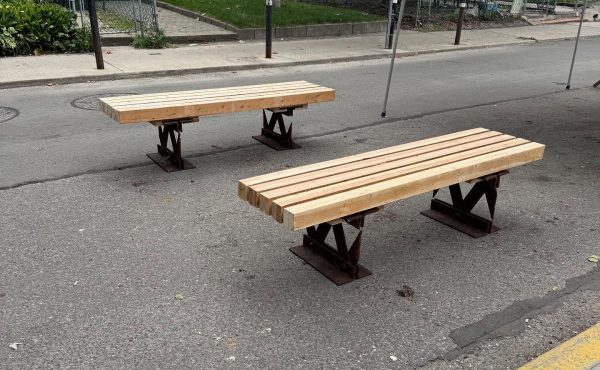
Some of you may be sitting at your desk today trying to kill time for the rest of the day so you can get out from behind your desk and finish up your holiday shopping. If you’re still stumped on what to get check out Spacing’s short-list of great book ideas we posted earlier in the week.
One of the books mentioned in that post was the Metropolitan World Atlas [ 010 Publishers ]. Since it arrived in our mailbox it has become a mainstay for me whenever I want to procrastinate. You can check out maps and a variety of stats on 101 of the world’s biggest cities (and their sprawling neighbours). Each of the cities is presented in a two-page spread: the left page highlights the ranking on the city on specific topics like average commuting time, employment, health, crime, rail and road usage, climate and pollution. The right-hand page is a map of the city, though its not very detailed.
Some interesting stats on Toronto: we have a residential density of 7,449 people every square kilometer. Compare that to Boston’s 3,151, Detroit’s 2,585, Miami’s 1,702, and Dallas’ 1,371 (which all have similar metropolitan populations to Toronto) and you start to see we’re doing okay, relatively, to other North American cities.
One of the smaller features in the front of the book that I really enjoyed was the ranking of population throughout the last 2000 years. Here’s the list:
| 100 AD: 1. Rome, Italy 2. Luoyang, China 3. Baghdad, Iraq 4. Alexandra, Egypt 5. Antioch, Turkey |
— 450,000 420,000 250,000 250,000 150,000 |
| 1000 AD: 1. Cordova, Spain 2. Kaifeng, China 3. Istanbul, Turkey 4. Angkor, Cambodia 5. Kyoto, Japan |
— 450,000 400,000 300,000 200,000 175,000 |
| 1500 1. Beijing, China 2. Vijayanager, India 3. Cairo, Egypt 4. Hangzhou, China 5. Tabriz, Iran |
— 672,000 500,000 400,000 250,000 250,000 |
| 1800 1. Beijing, China 2. London, UK 3. Guangzhuo, China 4. Tokyo, Japan 5. Istanbul, Turkey |
— 1,100,000 861,000 800,000 685,000 570,000 |
| 1900 1. London, UK 2. New York, USA 3. Paris, France 4. Berlin, Germany 5. Chicago, USA |
— 6,480,000 4,242,000 3,330,000 2,707,000 1,717,000 |
| 1950 1. New York, USA 2. London, UK 3. Tokyo, Japan 4. Paris, France 5. Shanghai, China |
— 12,463,000 8,860,000 7,000,000 5,900,000 5,406,000 |
| 2000 1. Tokyo-Yokohma, Japan 2. New York, USA 3. Seoul-Inchon, South Korea 4. Mexico City, Mexico 5. Sao Paulo, Brazil |
— 33,190,000 20,270,000 19,920,000 19,620,000 17,720,000 |
If you can find a copy of this book (try Ballenford Books at 600 Markham St, behind Honest Ed’s) it is well worth putting on your coffee table to impress your guests. Or even better, hide the book and memorize these stats to impress your buddies with your newfound “knowledge.”



13 comments
It looks beautiful, but I don’t think I could afford it, for myself or as a gift. How much does it go for?
I believe its in the $30-40 range.
A steal at twice the price.
No Chinese or Indian city in the top five? Really?
Here’s a scan of the rankings:
two childhood obsessions rolled into one: cities and maps!?
I just bought this 5 minutes ago!
…on another note: they have taken the largest figure for the urban populations. In the US they cast the net wide, creating such beasts as Washington D.C-Balitmore, a single urban blob that most people in Maryland would see as two cities. Oh well. if we play by those rules we can throw in the 500,000 Hamiltonians and bump T.O. a few spots.
Dave> Yeah, childhood obsession here as well.
Interesting re: DC and Baltimore blob — these new megalopolises are going to compete with the traditional idea people have of where they live. I was in Buffalo a month ago, and read things where Buffalo was considered part of the Golden Horseshoe. I liked that, and it seemed very futuristic. However, my experience with US customs spoiled any feeling of community I had.
Re: Buffalo as part of the Golden Horseshoe
Back when the Rochester Ferry was running, I heard locals referring themselves as part of the Horseshoe as well. That would pretty much take up the entire western half of Lake Ontario from Bowmanville through to Rochester if we counted them! The gap between Rochester and Buffalo/Niagara Falls seems pretty wide with Lockport being the only sizeable population between the two that I can think of.
Gil> Hmmm might as well just establish the Golden Circle, and bring Kingston and whatever NY State has to offer beyond Rochester. Sounds sort of religious though….maybe the Golden Hoop.
Or add a Waterloo-region “tail” to the horseshoe…
holy crap. i want this book. BAD.
as if i didn’t waste enough time as is…
m.
I went to buy this book today and it was over $60. Ouch. I ended up leaving it there, partially because I had assumed that the diagrams of the cities were all at the same scale, providing a visual comparison of their built up areas. When I realized it wasn’t the case, it tipped me to not buying it.
Anyways, comparing populations between cities is pretty much impossible, really. USA and Canadian definitions are different, so you can only imagine how hard it is, really, to compare Sao Paulo and Toronto in any meaningful way. As much as I hate to admit this, I think there’s no real way of coming up with comparisons between today’s mega cities.
There is no way Toronto has a residential density of 7,449. Wikipedia lists 3,939/km², and this is what it works out to if you divide the City of Toronto’s population by its area.
Maybe 7.5k is for the tiny old City of Toronto…
A question:
are the 101 maps all done to the same scale? If not, could you give the values for the two extremes?
thanks!